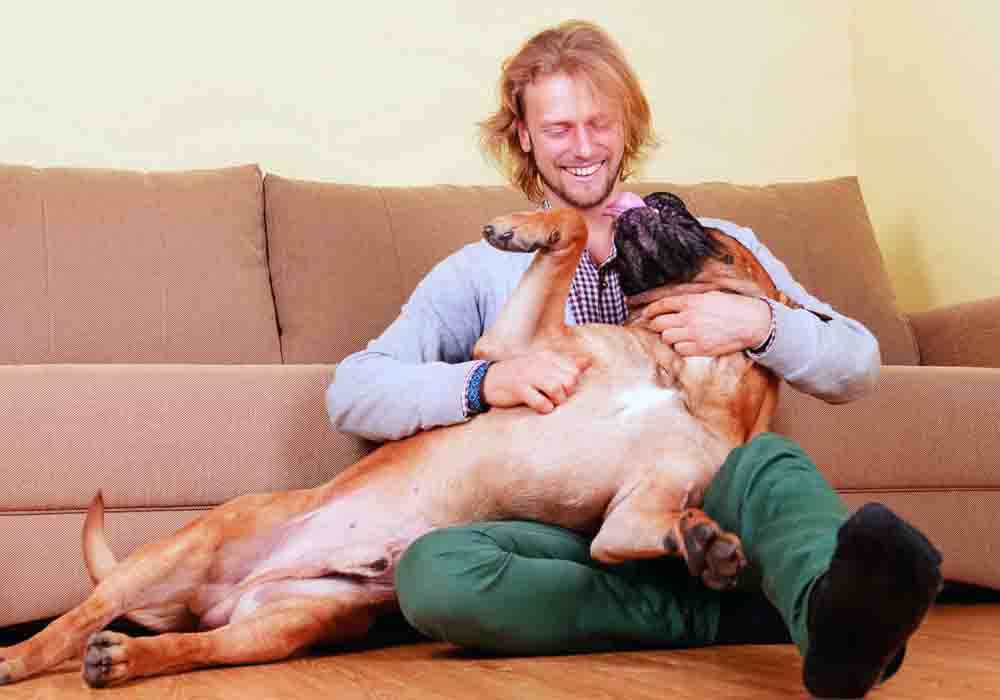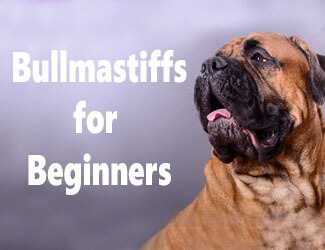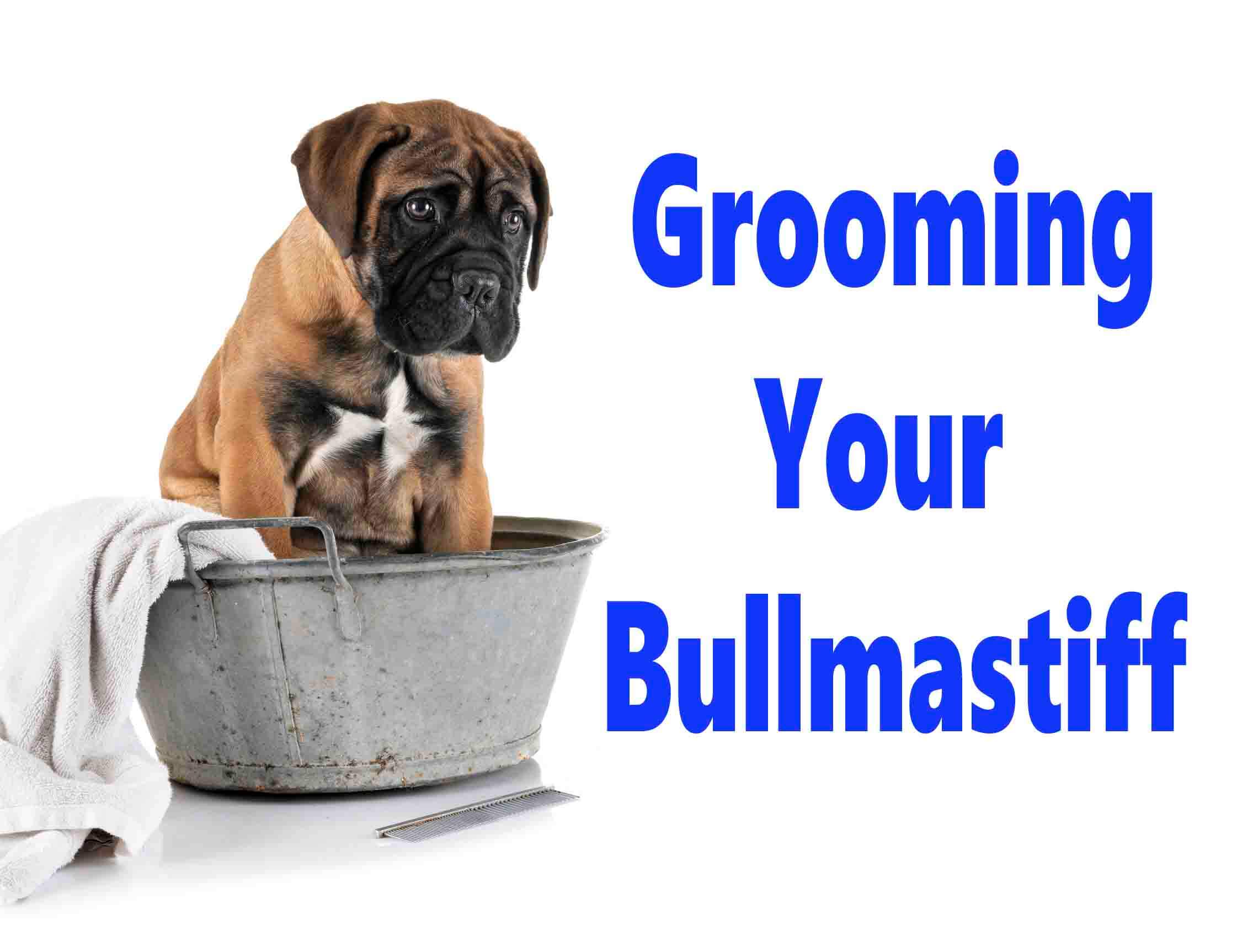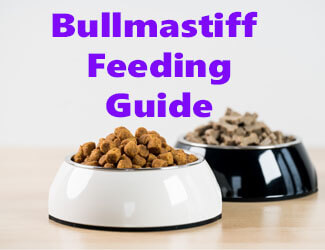Bullmastiff Good and
Bad
12 Pros And Cons To Be Aware Of
by Ken Alden
The Bullmastiff has an assortment of both good
and bad traits just like all dogs. Here are 8 of the 12 pros and cons of the Bullmastiff:
Bullmastiff Good And Bad...
Bullmastiff Good:
- They’re quiet.
- They’re great family dogs.
- They don’t need much exercise.
- They’re easy to groom.
Bullmastiff Bad:
- They don’t get along with other animals.
- They’re stubborn.
- They’re prone to obesity.
- They get separation anxiety.
In the rest of this article, we’ll go over these 8 pros and cons and the final 4 in greater detail. If you’re considering getting a Bullmastiff, you must read this before making a decision.
Pro-tip: Ever try lifting a Bullmastiff? Their weight can hurt not only your back but their joints when they hop down from cars, sofas or even your bed. To protect your back and theirs check out the best Mastiff ramps on Amazon.com now.

Bullmastiffs: What’s Good About 'Em
The Bullmastiff is a quiet breed that doesn’t bark much, but his snoring can be heard across the room. His ancestors were raised as watchdogs to protect massive estates, so he’s loyal and protective by nature. Still, he gets along nicely with the whole family (including children). bullmastiff good and bad
The Bullmastiff would rather spend time
lounging around the house than running around at full speed outside. He’s easy
to groom, and the shedding isn’t so bad if you brush him daily. Best of all,
he’s affectionate, loving, and caring.
1. They’re quiet.
Whether you live in a heavily populated apartment complex or just enjoy some peace and quiet sometimes, the relatively quiet lifestyle of the Bullmastiff might just be for you. That’s because the Bullmastiff’s barking habits are practically nonexistent.
Though considered a guard dog or watchdog, the Bullmastiff was never actually trained to bark or bite strangers. He’s simply expected to pin them down and keep them immobile until you can rush over to help.
The only time you’ll hear your Bullmastiff bark is when there’s a serious danger nearby, so be prepared to scope out the scene if he’s barking uncontrollably. Other than that, you likely won’t hear a sound from your Bullmastiff.
That is, of course, until it’s time to go to sleep.
The noise you will hear from your Bullmastiff is snoring, which he’ll be doing a lot of every time he’s taking a nap. The Bullmastiff is actually considered brachycephalic, meaning he has a short snout and difficulty breathing.
While you can’t do much about the snoring, you’ll eventually get used to it, and it’ll become background noise.
2. They make great watchdogs.
Back in the 1800s, the Bullmastiff was used as a guard dog. They were prized for their ability to guard massive country estates with relative ease. But, they were also known for protecting livestock and flocks from persistent poachers.
Even though the Bullmastiff is a little
nervous around strangers, he likely won’t attack unless there’s a serious
threat upon his family. What you can expect is a loyal companion that’ll spend
hours near a window or door, keeping track of who’s near his property.
But, just how did a Bullmastiff develop such a keen eye and ability to swiftly pounce upon approaching predators?
To fully understand, you need to learn about the two breeds that make up the Bullmastiff: The Mastiff and the Bulldog.
Both Bulldogs and Mastiffs have historically excelled as guard dogs. They’re known to recognize outside threats quite easily and don’t hesitate to attack or pin down strangers when their family is in danger.
So, the Bullmastiff is the perfect combination of each.
Pro-tip: Bullmastiff anxiety, aggression, destructive chewing, jumping up, fearfulness, and other behaviors can be controlled with the right training program.
Here’s a great course that
addresses these issues along with many other dog training basics: Check it out now!
3. They’re great family dogs.
The Bullmastiff seems a little intimidating to most, but he’s known for being relatively calm and never rambunctious. While he does appreciate some exercise every once in a while, he’s more likely to enjoy hanging around the house with his loving owners.
If you put in the time and effort to properly
socialize your Bullmastiff from a young age, he’ll likely get along well with
strangers after a few introductions. However, he’ll always be suspicious of new
people around his family.
You'll enjoy reading about how great they are as family dogs in this article of ours.
Yet, the greatest characteristic of the Bullmastiff is just how gentle he is with the little ones. Even though he might weigh five times as much as your toddler, he’ll love to play with them and won’t ever take it too far.
You just want to make sure that you’re teaching your children how to properly interact with a dog. That means warning them not to get in your Bullmastiff’s face, avoid pulling his tail, play fetch and tug-of-war, and learn the commands your Bullmastiff follows.
4. They don’t need a ton of exercise.
The Bullmastiff does like to exercise here and there, but he doesn’t require all that much exercise on a daily basis. He would much rather lie on the couch with you, cuddle up with your kids at nap time, and follow you around as you do your chores.
For the most part, you should be okay giving your Bullmastiff one long walk every day. About 30 minutes of walking should be decent, but a little more exercise can help if your Bullmastiff seems to be a little more energetic than usual.
When it is time to exercise, you need to limit the intensity of the exercise since your Bullmastiff has fragile joints. So, take it easy by just throwing a ball around the backyard or engaging in a short tug-of-war battle with your powerful Bullmastiff.
Be careful about exercising your Bullmastiff in hot and humid weather. Since the breed is brachycephalic and large in size, they’re much more likely to develop heatstroke, which is a very serious condition.
Make sure he always has access to water and
bring him inside if he seems to be getting hot.
5. They’re easy to groom.
Even though the Bullmastiff sheds year-round, the shedding wouldn’t be considered “excessive.” You just have to make sure that you’re grooming him on a consistent basis to keep that tough Bullmastiff hair off of your furniture.
A quick daily brushing should be just fine to get rid of any loose hairs that are holding on for dear life. However, you might be able to get away with brushing your Bullmastiff only once a week if the shedding isn’t too severe.
Because loose hair is usually the problem (and not matting), a rubber glove brush might be the quickest way to get those daily brushings in. Your Bullmastiff will think he’s just getting some attention without knowing he’s actually being groomed.
It’s a win-win.
In terms of bathing, you’re in luck. The
Bullmastiff only needs to be bathed a few times a year, unless he’s the type of
pup that loves to roll around in the dirt, mud, and grass.
6. They’re affectionate.
The Bullmastiff is definitely not the type of dog that simply coexists with you and your family. He wants to be involved in nearly everything you do and will likely be by your side almost every second of the day. Bullmastiff good and bad
He just wants to spend time with you no matter what you’re doing. So, make it a point to include him in your family outings if you can.
The Bullmastiff loves to cuddle and snuggle while you’re watching TV and might even try to sneak up on your bed in the middle of the night. When it’s playtime, he loves to build a bond with you through exercise.
Even better is that he’s always excited to see
you! He’ll most likely come prancing over to you the second he sees you walking
up the driveway and greets you with an insane number of kisses and jumps.
Pro-tip: Bullmastiff's (and their owners) love dog crates…and for good reasons. Crates keep dogs from mischief while you're away, are perfect for house training, for traveling by car, and provide the dog a place to de-stress. Check out the best Mastiff crates on Amazon.com now.
Bullmastiffs: What’s Bad About 'Em
The Bullmastiff is best as an “only dog,” so you’re going to want to pass on this breed if you already have dogs and cats at home. He’s a little stubborn and might be a little reluctant to follow your rules. The Bullmastiff is also prone to getting a little chubby, so a healthy diet is a must.
His attachment to you is cute, but the
destructive habits when you’re away might get a little tiring after a while.
The Bullmastiff does best with an experienced owner who’s a confident and
dominant leader. Last but not least, the Bullmastiff drools - a lot!
7. They don’t get along with other dogs or cats.
Your Bullmastiff is great with the two-legged members of your family, but he won’t do so well with those with four legs. That’s because the Bullmastiff is both highly territorial and has an insatiable prey drive.
He sees most dogs of the same sex as a threat, so he’s likely to get aggressive and even attack if he feels there’s a competition for dominance. If you really want another dog that badly, get a dog of the opposite sex and properly socialize them.
That also means that your Bullmastiff won’t make too many friends if you were to let him loose at the dog park. So, avoid bringing your Bullmastiff around other dogs if you can and keep him securely harnessed and leashed when you’re outside.
Neither a Bullmastiff nor a cat will enjoy
being in the company of one another. The Bullmastiff will absolutely torment
the cat and chase him around because of his high prey drive, so cats won’t be a
great idea for a home with a Bullmastiff.
Learn More...This helpful article of ours talks more about Bullmastiffs and other pets and how well they get along.
8. They’re a little stubborn.
The Bullmastiff isn’t all that hard to train, but he might be a little reluctant to learn new rules at first. That’s because he wants to see what he can get away with and is definitely going to push the boundaries you’ve set in place.
To avoid the stubbornness, you need to work on training from the time your Bullmastiff is only a few months old. He needs to get the hang of the basic commands like sit and stay while also knowing what he can and can’t do in the house.
Most importantly, you need to use positive reinforcement. The Bullmastiff typically doesn’t respond too well to yelling or physical abuse, meaning he might get aggressive or see you as an enemy after a few bad interactions.
Remember, he’s a big dog, but he can be kept
in line with a little hard work. Otherwise, you’re going to have a 100-pound
dog running the show.
9. They’re prone to obesity.
Because the Bullmastiff is a low energy dog with a nearly insatiable appetite, he’s more likely to develop obesity than some other breeds. That means you need to keep a close eye on what you feed your Bullmastiff and how much he’s eating.
But, an overweight dog doesn’t just mean he’s a little hefty. A few extra pounds on large frame dogs like the Bullmastiff puts a lot of extra pressure on his joints, meaning he might be more prone to joint conditions like arthritis or hip dysplasia.
The best thing you can do? Feed him based on his weight, not on his appetite.
No matter how much he begs for table scraps,
every calorie counts. So, if you notice that your Bullmastiff is getting a
little chunky, reduce his food intake every day and work on getting a little
more daily exercise.
10. They’re likely to suffer from separation anxiety.
There’s no doubt that your Bullmastiff’s desire to be around you constantly is a great feature and makes you feel important, but it can also take a turn for the worse. That’s especially the case when he develops separation anxiety.
Your Bullmastiff definitely won’t enjoy being alone for too long, so this isn’t the right breed for you if you spend a lot of time at the office or away from home. Your Bullmastiff craves your attention and love and, without it, he gets very emotional.
And by emotional, we also mean destructive.
When dogs experience separation anxiety, they get sent into an intense panic. Your Bullmastiff might relieve himself indoors, whine and cry for hours until you get home, and even tear up your furniture.
While he means no harm, it’s definitely a lot
more you have to worry about. So, it’s important that you get your Bullmastiff
accustomed to being alone for short periods of time or settle for
another breed that’s more independent.
11. They require an experienced owner.
Since the Bullmastiff is a little stubborn and likes to test your rules, he’s going to see what he can get away with. That means he might try to assert himself as the leader of the house unless you have something to say about it.
If you even bend the slightest bit, he’ll take it and run with it. Before you know it, you have a Bullmastiff telling you when he eats, when he goes out to play, and what furniture he’s allowed to tear up. Bullmastiff good and bad
So, you need to be a confident leader that’s willing to put him in his place. That means puppy classes might be a good idea when he’s young.
When you go to puppy classes, your Bullmastiff will learn some new commands, but you’ll also be taught how to be a dog owner. These classes are more about training you and helping you to mold the relationship you have with your Bullmastiff.
The Bullmastiff is definitely better in the
hands of an experienced dog owner that knows how to build a relationship with a
dog. Bullmastiff good and bad
12. There’s a lot of drool.
The Bullmastiff has some of the greatest features of the Bulldog and the Mastiff, but he also has their drooling habits too! Since the Bullmastiff tends to have loose lips, he can’t help but drool when he’s hungry, thirsty, or just playing in the yard.
As a Bullmastiff owner, you’re always going to
need a rag on hand to clean up drool splotches that find their way onto your
furniture and floors. You might also want to invest in a doggie bandana or bib
to catch slobber as it falls.
Just how bad do they drool? Our article here gives an interesting comparison to other Mastiff breeds.
Bullmastiff Good And Bad...Final Thoughts
Given the rising popularity of the Bullmastiff, there’s no doubt that this is a great breed if you’re looking for a loyal watchdog and friendly companion. Here are some things you absolutely need to know about Bullmastiffs before bringing one home.
- They snore loudly and drool a ton, but they’re pretty easy to groom and don’t bark much.
- They’re not great with other dogs and cats but are usually great with kids.
- They’re affectionate, loyal, and build a close connection with the whole family.
- They need an experienced and confident owner.

About the Author...
Ken Alden, a dedicated Mastiff owner for over eight years, is acclaimed for his expertise in care, grooming, and training. Read more About Me and my dog Shadow.
- Mastiff Guide Home ›
- Bullmastiffs ›
- Bullmastiff Good And Bad






